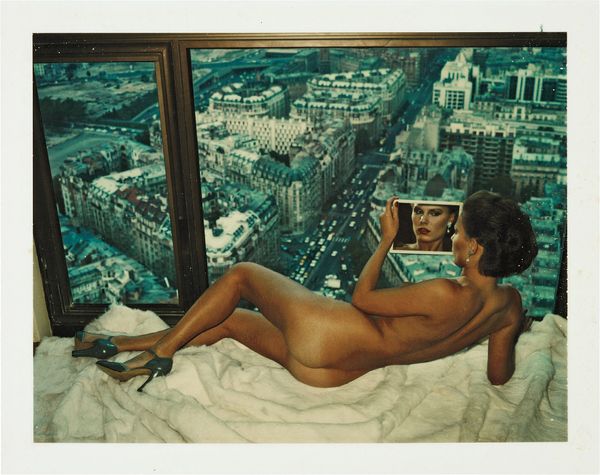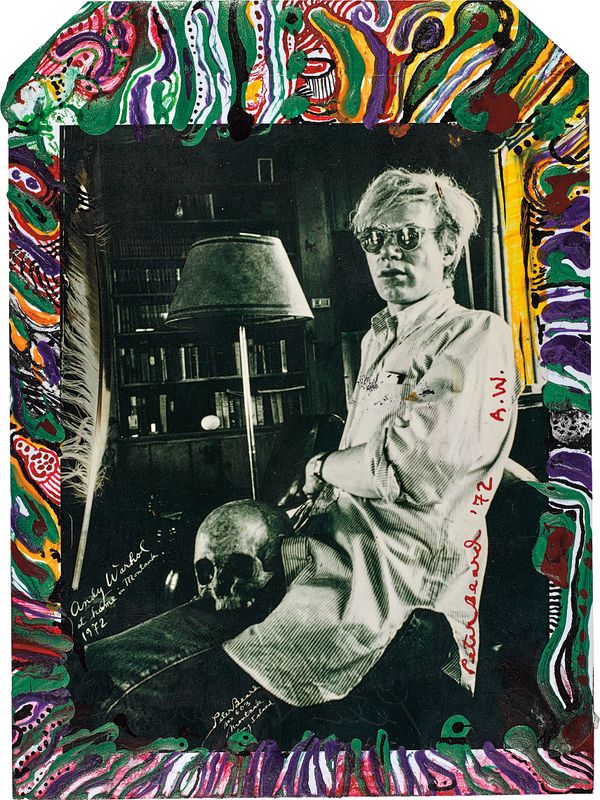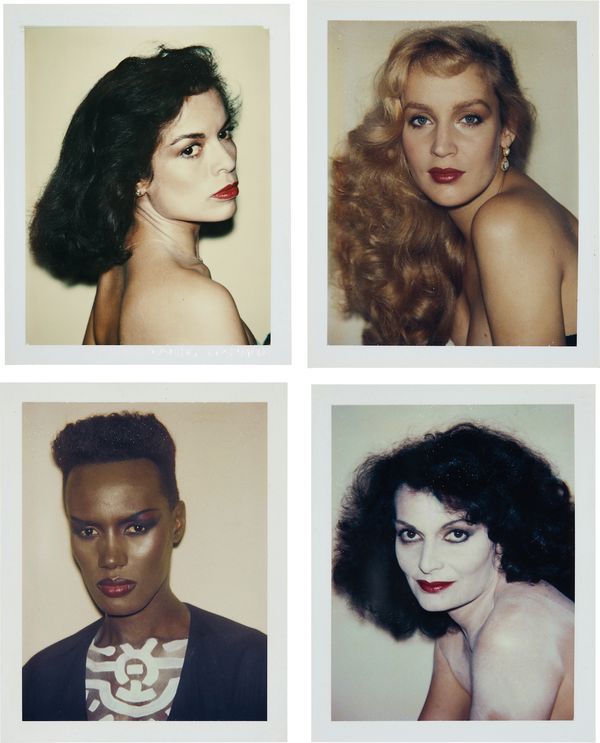Andy Warhol Debbie Harry, 1980
Piero Bisazza has one passion aside from mosaics — Polaroids. The CEO of Bisazza since 2000, Piero has led his family business to become an international luxury brand as one of the world's leading producers of glass mosaics. In 2012, he and his sister Rosella inaugurated the Bisazza Foundation, a 6,000 square meter exhibition space designed by the architect Carlo Dal Bianco, featuring a permanent collection of works by a wide range of artists, architects and designers, including Marcel Wanders, Sandro Chia and Mimmo Paladino. Recent temporary solo shows have included John Pawson, Candida Höfer and Nobuyoshi Araki.
Each handmade Bisazza mosaic tile is small and unique—qualities that Piero recognizes as having drawn him to Polaroids: "I like small things." First introduced in 1948, Polaroid technology revolutionized photography by offering instant access to the final print. This spontaneity appealed to Piero as he built his collection of Polaroids. "It's an instinctive collection," he explained. "I plan nothing."
Piero acquired his first Polaroids after meeting Helmut Newton at Los Angeles' Chateau Marmont in January 2004. In the Collection, Polaroids by Newton constitute the largest number of works by a single artist (lots 8-11, 152-163). Eroticism is an underlying theme that extends to the work of other artists, including Nobuyoshi Araki (lot 7), Paolo Roversi (lots 169-170) and Carlo Mollino (lot 172).
It's an instinctive collection...I plan nothing.
— Piero Bisazza
Helmut Newton Bergström over Paris, 1976
Peter Beard Andy Warhol at Home in Montauk, 1972
Piero's Collection addresses the multitude of ways in which artists use the Polaroid. For Newton, the Polaroid acted as his sketchbook. Andy Warhol took many Polaroids of his subjects in search of the perfect pose that would be immortalized in one of his silkscreens (lots 2-6). Robert Mapplethorpe's Polaroids are often seen as his entry into photography (lot 1), whereas Peter Beard draws on his Polaroids with ink and paint as an extension of his creative process (lots 164-168).
The featured works from Piero's Collection represent the culmination of nearly 15 years of collecting Polaroids. Spanning our ULTIMATE Evening & Photographs Day Sales this May in London, the selection presents collectors an unrivaled opportunity to acquire unique Polaroid prints that provide an intimate and insightful glimpse into the working practices of 20th and 21st-century masters.
Robert Mapplethorpe and the Polaroid
Patti Smith was the first person Robert Mapplethorpe photographed and the only person he photographed more than himself. Mapplethorpe and Smith first met in 1967. As lovers and then as friends, they supported each other through developments in their creative pursuits. In 1970, Mapplethorpe first picked up a Polaroid camera when he borrowed one from fellow artist and Chelsea Hotel neighbor Sandy Daley. "I was Robert's first model and he was his second," Smith recalls in her memoir Just Kids. "The settings and options were limited but it was technically simple and he needed no light meter." While, early on, Mapplethorpe economized on food in order to buy Polaroid film at $3 a pack, in 1971, John McKendry, then Curator of Photography at The Metropolitan Museum of Art, purchased Mapplethorpe his own Polaroid camera and helped the artist to obtain a grant from Polaroid via their Artist Support Program for unlimited film.
The bulk of Mapplethorpe's Polaroids were taken in 1970-75, and it was during this time that he first discovered his love for photography. "I never anticipated Robert's complete surrender to its powers. I had encouraged him to take photographs to integrate into his collages and installations," Smith writes, "but Robert shifted his focus, the photograph was not a means to an end, but the object itself." Mapplethorpe's Polaroids provide a fascinating insight into his early experimentation with light, composition and representations of the body, which would become the foundation of his later work.
He was the artist of my life.
— Patti Smith
Robert Mapplethorpe Untitled (Patti Smith), 1973-1975
In the Polaroid offered here, Patti Smith is partly blurred, caught mid-turn, but her eyes remain fixed on Mapplethorpe, her soulmate. According to Smith, Mapplethorpe "saw more in me than I could see in myself. Whenever he peeled away the image from the Polaroid negative, he would say, 'With you, I can't miss.'" From the very beginning of his appreciation for this instant medium, he photographed his friend, muse and lover Patti Smith, capturing the intimacy that transcended their relationship. This lot is the only Polaroid by Mapplethorpe in the Piero Bisazza Collection.
Andy Warhol and the Polaroid
During the 1970s up until his untimely death in 1987, Andy Warhol's camera of choice for his silkscreen portraits was the Polaroid Big Shot. A close-up camera with a fixed focal lens and built-in flash, the Big Shot was perfect for taking portraits and made it easy for Warhol to quickly take multiple shots of his subject. To prepare for the shoot, women's faces were often painted with white makeup to achieve a smooth appearance and men were posed to conceal any flaws. For most sittings, Warhol was known to go through a few packs of film, and at the end of a shoot, he would select a small number of Polaroids to be sent off and re-photographed in 35mm, printed as 8 x 10 acetates and then re-printed in 40 x 40 to be finally transformed into the silkscreens.
My idea of a good picture is one that's in focus and of a famous person.f
— Andy Warhol
Andy Warhol Bianca Jagger, Jerry Hall, Grace Jones, Diane von Fürstenberg, 1974-1984
Most of these portraits were done on commission or trade. Both Roy Lichtenstein and Gilbert & George (lot 5) traded their paintings with Warhol for his silkscreen portraits. The Polaroid was the foundation for his 1970s and 80s silkscreen portraits, and the Big Shot, with its speed and disposability, suited the purpose. These 11 Polaroids, comprising lots 2-6, offer a unique record of the famous faces that populated the world of Andy Warhol, 20th century's preeminent visual artist.
Nobuyoshi Araki and the Polaroid
In 2009, after Piero Bisazza had started collecting Polaroids by Nobuyoshi Araki, he invited the Japanese photographer to shoot a campaign for his mosaic company Bisazza. "I've always admired Araki's photographic style, in particular, his use of color," Piero explains. "In our advertising campaign, Araki was able to harmoniously match the brilliance of the golden mosaics with the vivid colors of the models' kimonos." Eight years later in 2017, the Bisazza Foundation presented a solo exhibition of Araki's work from the 1970s onwards with his Tokyo, kinbaku [bondage] and flora images, as well as his more recent work such as his 2014 Love on the Left Eye series. The exhibition featured an installation around Araki's 2009 Bisazza campaign with a video of the artist painting onto the mosaic tiles and creating the advertising images.
Why do they come across as erotic? Because I shot them. That’s what my photos are.’
— Nobuyoshi Araki
Highlights from Nobuyoshi Araki 36 Polaroids, n.d.
The Polaroid camera is one of the many tools Araki uses to sustain his prolific output. Throughout his unrivaled six-decade-long career, Araki, who will be 78 in May this year, has documented the people, events and sights that move him. He is constantly in the act of image-making and re-examining what it means to take photographs. Each taken with a Polaroid 600 camera, the featured lot features 36 unique Polaroids of nudes, bondage and flowers, and together celebrate Araki's distinctive eroticism.
Helmut Newton and the Polaroid
Helmut Newton started taking pictures with the Polaroid camera in the 1970s, using it to test lighting conditions and see instantly how a situation would appear photographically. After a day of shooting, he would come home and share his Polaroids with his wife June, who would sometimes use them as place cards at dinner parties. In 1992, Newton decided to officially position these works within his oeuvre and published Pola Woman, a personal project that showcased his Polaroid prints. The Polaroids in the book were accompanied by Newton's short captions about the shoot or the model, emphasizing his intimate relationship to these images.
Arielle was one of my favorite girls at the time. She made my camera sizzle...
— Helmut Newton
Helmut Newton Arielle for Amica, Milan, 1982
Many of the Newton Polaroids found in the Piero Bisazza Collection are the actual prints reproduced in Pola Woman. Such examples in the sale include the cover of Pola Woman, Arielle for Amica, Milan, Prunella and Sylvie on the Quai d'Orsay for Playboy and the first Polaroid in Pola Woman, Modelling Fashion for Vogue Hommes. Polaroids of such quintessential Newton images as Bergström over Paris and Sylvia in My Studio are also featured. Together, these works offer a captivating insight into how ideas were formed in Newton's restless imagination and reveal the eye of a master photographer.
Browse our catalogue for the full selection of POLAROIDS from the Piero Bisazza Collection in the Photographs Day Sale.






